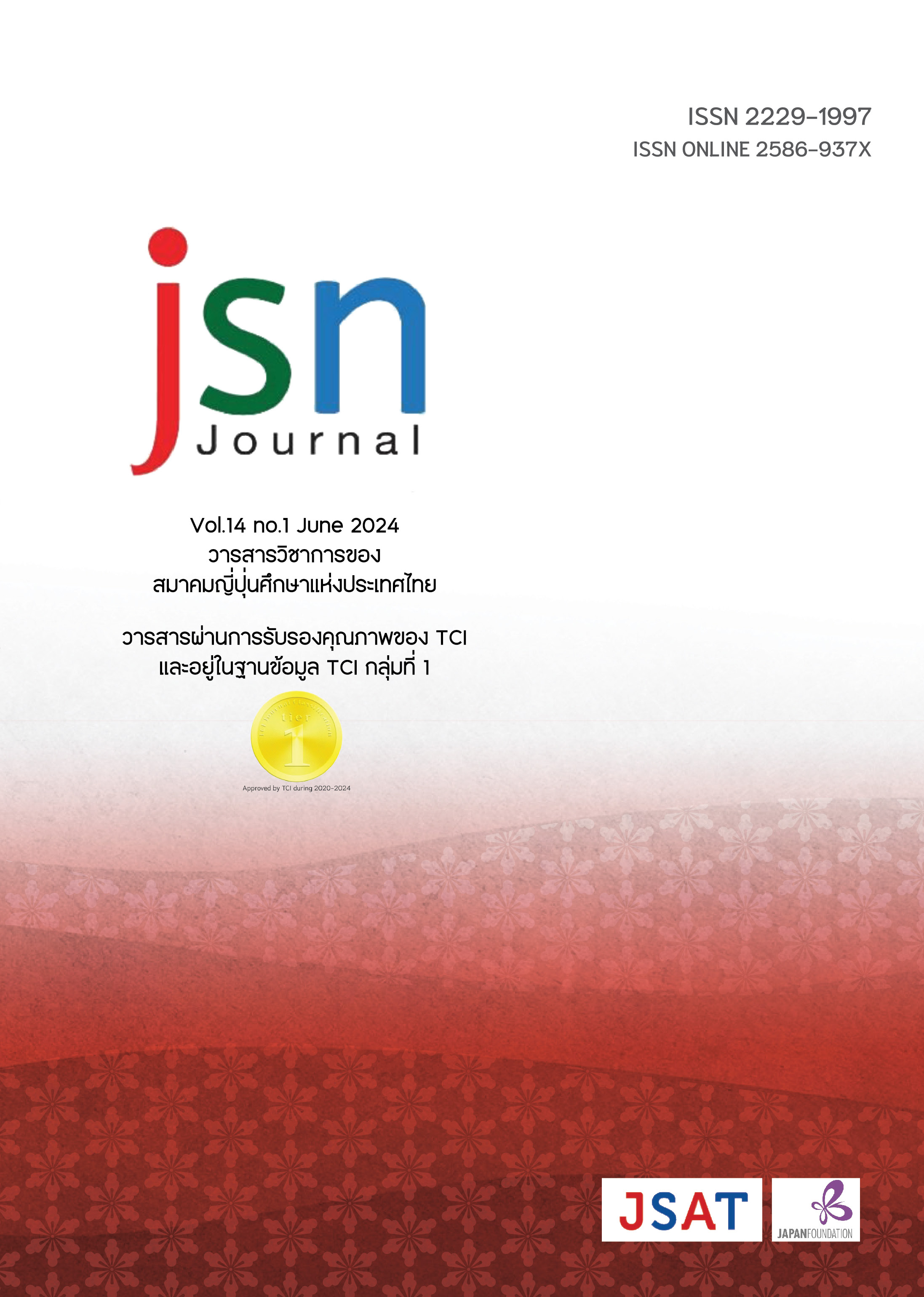Cultural Politics in the 1923 Great Kanto Earthquake: From the Earthquake to National Spirit Restoration
Main Article Content
Abstract
The 1923 Great Kanto Earthquake was not only Japan's most catastrophic disaster, it also represents a social and cultural incident that reflected the social values and political ideologies of the society. While most earthquake studies in Thailand focus on scientific data and disaster management, they often neglect the social and historical impacts. Therefore, this article aims to study the history and social responses to the Great Kanto Earthquake in order to understand the cultural politics of the incident. The study found that this earthquake was the most destructive in Japan’s history, characterized by a large and long-lasting fire that caused enormous damage and numerous deaths. Japan's response to this disaster can reflect the social values and political ideologies of the society. The elite and intellectuals interpreted the earthquake as divine retribution for the Japanese. They asserted that it is time for the Japanese people to awaken from their obsession with Western values and to embrace traditional Japanese values once again. The government also utilized the earthquake as a symbol to revive the national spirit.
Article Details

This work is licensed under a Creative Commons Attribution-NonCommercial-NoDerivatives 4.0 International License.
ข้อความและข้อคิดเห็นต่างๆ ในบทความเป็นของผู้เขียนบทความนั้นๆ ไม่ใช่ความเห็นของกองบรรณาธิการหรือของวารสาร jsn Journal
References
กัมปนาท รักษ์ชน. (2013). บาดแผลทางจิตใจของตัวละครในเรื่องสั้นชุด คะมิ โนะ โคะโดะโมะตะชิ วะ มินะ โอะโดะรุ ของมุระกะมิ ฮะรุกิ. [วิทยานิพนธ์มหาบัณฑิต คณะอักษรศาสตร์] จุฬาลงกรณ์มหาวิทยาลัย.
ซูซูกิ จุน.(2023). ถอดบทเรียนจากแผ่นดินไหวใหญ่คันโต (ตอนที่ 1) (関東大震災の概要とその教訓) . http://www.ias.chula.ac.th/article/ถอดบทเรียนจากแผ่นดินไหว
ประจักษ์ ก้องกีรติ. (2015). การเมืองวัฒนธรรมไทย: ว่าด้วยความทรงจำ/วาทกรรม/อำนาจ. นนทบุรี:สำนักพิมพ์ฟ้าเดียวกัน.
ธนิกุล จันทรา. (2021). อาสาสมัครดิจิทัลกับการจัดการภัยพิบัติ: ประสบการณ์จากเหตุการณ์ แผ่นดินไหวใหญ่ทางฝั่งตะวันออกของประเทศญี่ปุ่น. Journal of Liberal Arts (Maejo University), 9(2), 238-253.
นงลักษณ์ ลิ้มศิริ. (2015). สื่อ-ผู้คน: การส่งความฝันความหวังและอนาคตในวิถีญี่ปุ่น. Panyapiwat Journal, 7, 261-271.
นรีนุช ดำรงชัย. (2016) ประวัติศาสตร์กับการเรียนรู้เพื่อเตรียมพร้อมกับภัยพิบัติทางธรรมชาติของญี่ปุ่นยุคร่วมสมัย.วารสารญี่ปุ่นศึกษา, 31(1), 61-78.
นรีนุช ดำรงชัย. (2017). “โบซะอิเคียวอิกุ”: การให้ความรู้เกี่ยวกับภัยพิบัติในประเทศญี่ปุ่น. เอเชียปริทัศน์, 40(2), 127–157.
นรีนุช ดำรงชัย. (2019). ญี่ปุ่นยุคร่วมสมัย : สังคม การเมือง เศรษฐกิจ และวัฒนธรรม. กรุงเทพฯ: สำนักพิมพ์สถาบันบัณฑิตพัฒนบริหารศาสตร์.
พิพาดา ยังเจริญ. (1996). ประวัติอารยธรรมญี่ปุ่น. กรุงเทพฯ: โรงพิมพ์จุฬาลงกรณ์มหาวิทยาลัย.
เพ็ญศรี กาญจนโนมัย. (1995). ญี่ปุ่นสมัยใหม่. กรุงเทพฯ: เนติกุลการพิมพ์.
วรรณวลี อินทร์ปิ่น. (2021). ธรรมาภิบาลกับการจัดการภัยพิบัติ: กรณีศึกษาการจัดการบ้านพักชั่วคราวในจังหวัดคุมะโมะโตะ ประเทศญี่ปุ่น. jsn Journal, 11(2), 51-68.
ศิริพร ดาบเพชร. (2016ก). ญี่ปุ่นกับการสร้างจักรวรรดินิยม.กรุงเทพฯ : ภาควิชาประวัติศาสตร์ มหาวิทยาลัยศรีนครินทรวิโรฒ.
ศิริพร วัชชวัลคุ. (2016ข). ญี่ปุ่นกับการจัดการเชิงสถาบันสำหรับการให้และรับความช่วยเหลือเพื่อบรรเทาทุกข์และปฏิบัติการเพื่อมนุษยธรรม: กรณีศึกษาเหตุการณ์มหาภัยพิบัติ 3 ประการในปี2011. jsn Journal, 6(1), 1-20.
สุรางค์ศรี ตันเสียงสม. (2008). ประวัติศาสตร์ญี่ปุ่นสมัยใหม่. กรุงเทพ: สถาบันเอเชียศึกษา จุฬาลงกรณ์มหาวิทยาลัย.
อัจฉราวรรณ อิศรางกูร ณ อยุธยา. (2014). สื่อพื้นบ้านผสานการป้องกันภัยพิบัติสมัยใหม่:การจัดการ“ตะกอนไหล”หุบเขาคิโซะจังหวัดนะงะโนะ. เอกสารหลังการประชุมวิชาการระดับชาติ สมาคมญี่ปุ่นศึกษาในประเทศไทย ครั้งที่ 7, 169-186.
Bankoff, G. (2003). Cultures of Disaster: Society and Natural Hazard in the Philippines. London: Routledge/Curzon.
Borland, J. (2005). Stories of ideal Japanese subjects from the great Kanto earthquake of 1923, Japanese Studies, 25(1), 21-34. DOI: 10.1080/10371390500067645.
Gordon, A. (2003). A Modern History of Japan: From Tokugawa Times to the Present. New York: Oxford University Press.
Oldtokyo. (2023). The Great Kanto Earthquake. https://www.oldtokyo.com/1923-great-kanto-earthquake.
Schencking, J. (2008). The Great Kanto Earthquake and the Culture of Catastrophe and Reconstruction in 1920s Japan. The Journal of Japanese Studies, 34, 295-331. DOI:10.1353/jjs.0.0021.
Takashima, H. (1923). "Hensai o kikai ni" Jido kenkyu, 27(2), 71-72.
安部磯雄 (1923).「帝都復興に要する大なる犠牲」『改造』5(10),17-23.
宇垣一成 (1954).『宇垣一成日記1』東京:朝日新聞社.
大川周明 (1927).『日本精神研究』東京:行地社.
梶田真 (2019).「関東大震災,空襲と町丁別にみた東京中心部の社会–空間ハターン変化(1920-1965)」『地学雑誌』128(6), 855-878.
国立公文書館 (n.d.) . 「国民精神作興ニ関スル詔書」, 国立公文書館. https://www.digital.archives.go.jp/img/1722286.
鈴木淳 (2016).『関東大震災 消防・医療・ボランティアから検証する』東京:講談社.
東京百年史編集委員会 (1973).『東京百年史』第1巻, 国立国会図書館デジタルコレクシン. https://dl.ndl.go.jp/pid/9640952.
子安宣邦 (2016).「大川周明と『日本精神』の呼び出し1」. http://www.nikkanberita.com/read.cgi?id=201604241628210.
内閣府政策統括官 (2007).「過去の災害に学ふ(第14回):1923年関東大震災‐火災被害の実態と特徴‐」『広報ほうさい』40,12-13.
内閣府政策統括官 (2023).「関東大震災100年」特設ページ. www.bousai.go.jp/kantou100.
日本書籍株式会社 (1910).『尋常小学修身書巻巻一』東京:日本書籍株式会社. https://www.archives.go.jp/exhibition/digital/meiji/contents4_07/01.html.
深作安文 (1924).『社會創作への道』東京:廣文堂書店.
福田徳三 (1923).「復興日本当面の問題」『改造』5(10), 9-13.
文部省普通学務局 (1923).『震災に関する教育資料』第3輯,文部省普通学務局,大正12.国立国会図書館デジタルコレクション. https://dl.ndl.go.jp/pid/981857.


